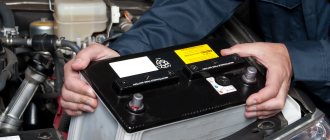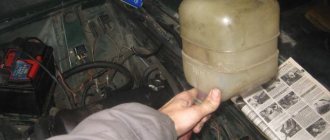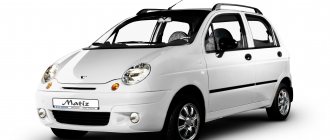Whether to warm up a car before driving or not is an age-old question that causes heated discussions in motorist circles with the arrival of cold weather, especially winter frosts. In fact, the clear answer is to heat it. Another thing is how much time and by what methods - here the decision is made by the driver individually depending on several factors.
- 2 How much time is required in summer, spring and autumn
- 3 How long should you warm up your car in winter?
- 4 What happens if you don’t do this
Why do you need to warm up your car?
During frosts, do not forget to check the condition of the battery and the functionality of the generator using a voltmeter
Operating a car according to the “key and go” principle, even in 40-degree heat, will not lead to anything good. Most engines are designed for an operating temperature of +90 °C, so the sultry +40 °C, at which we are thirsty, is not enough for the engine.
The main reason why it is necessary to warm up the car is that the engine runs dry, without lubrication, for the first 30 seconds after starting, regardless of the time of year and air temperature. Engine oil needs time to rise from the crankcase and fill the gaps between the rubbing parts of the power plant. And the colder it is outside, the thicker it is and, accordingly, the slower it enters the engine. And it starts working when it heats up to that same + 40 °C.
Warming up a car in winter: what is it for?
For many car enthusiasts, warming up their “iron horse” in winter is more a tradition than a necessity. They don’t even think about how long they need to warm up the car in cold weather and why it needs to be done - it’s just that this experience is passed on from generation to generation.
Some car owners are sure that the engine needs the procedure. Such drivers are convinced that with this simple action they extend the life of the engine. In fact, it is not so much the power unit that needs heating (it will work and pull the car at any temperature), but rather the oil pump and its contents.
At low temperatures, lubricants thicken, and accordingly, the oil pump cannot pump oil properly. The mechanism works at the limit of its capabilities and can quickly break down if the car is not warmed up in the cold season.
To avoid breakdowns, you need to warm up the engine to at least 50° - this is the normal temperature at which the oil “melts” and its movement through the mechanisms begins. If you intend to immediately “give on the gas” and operate the car to its fullest, it is better to warm up the engine almost to full - up to 90°. This way the lubricants will feel comfortable and perform their task.
By the way, switch to winter oil or a universal composition in the cold season. The assortment can be viewed in the catalog on the website of the online store “Wheels for Free”. Having chosen the desired composition, order delivery throughout Russia. We have various promotions and pleasant bonuses.
If you do not pay attention to such an important point as the seasonal composition of lubricants, problems may arise. Let's say, with summer oil you will not be able to start your car in winter at some point.
How long does it take in summer, spring and autumn
The engine warms up faster while driving than when idling.
The lower the air temperature, the longer it takes to warm up the car, even the most modern one. Accordingly, in summer, as well as in warm spring or autumn, 1 minute will be enough, after which you can start moving.
In general, you should focus not on the time of year, but on the air temperature outside. The dependency here is as follows:
- above + 15 °C - 1 minute of warming up is enough;
- +10…+15 °C - about 3 minutes of warm-up;
- 0…+10 °C - about 5 minutes of warm-up.
It is not at all necessary to rattle the engine while standing in the yard. At positive temperatures, you can start driving after the first minute of engine operation, but at low speeds - up to 2000. Do not spin the engine any further until it warms up to operating +90 °C. This will happen faster while moving.
How to quickly warm up a car interior
Important elements such as:
- Ambient temperature and wind speed. Every driver understands that he is unable to change these parameters, but he can still take some measures. For example, to warm up the engine, move through a closed area of the territory rather than an open one, if possible. You won’t gain much time here, but it may still be enough for the engine to heat up to the required temperature. How to quickly warm up the windows in a car in winter or the interior - such a question will no longer be relevant for an indoor area.
- An experienced driver will say that the speed of the car plays a big role in quickly heating the interior and engine of the car. The more revolutions the driver gives, the faster the engine warms up. If we compare old carburetor engines, they had an advantage over modern ones, since with the help of a special suction it was possible to carry out this operation much faster. For carburetor engines, it was possible to close the damper, which helped the temperature reach a high value faster, thereby heating the engine faster. After this, the main thing was not to forget to open the damper, otherwise sad consequences could occur.
- It is necessary to put a load on the engine. The question of how to warm up a car faster in winter with an automatic or manual transmission is very relevant among car owners. The greater the load, the faster the warm-up. But here it should be understood that giving a cold engine a large load at once is also very harmful, since cold oil cannot yet ensure the performance of all its functions at the proper level; in addition, thermal clearances have their own disadvantages in a cold state.
- Heat transfer to the heater. It should be understood that this also plays a role in warming up the interior and engine. It is clear that the warmer it is inside, the faster the motor will reach the required temperature. If at such temperatures the fan spins at maximum speed, you will only add coldness inside the cabin, but this will not affect the engine in any way. In this case, it is better to be patient a little, stand still, let the car warm up and get the engine to at least a little temperature. Modern cars are equipped with energy-efficient motors that automatically supply warm air to the engine - this is a good development by one of the companies that is in great demand among all consumers.
- The presence of additional systems that perform the heating function. Now there are devices without which drivers cannot imagine their car operating.
These devices include autonomous heaters.
This device uses what is in the tank as fuel. The disadvantage of such devices is that they can quickly drain the battery. This device for a vehicle can be purchased at any automotive store.
Very often, many questions arise between experienced and younger drivers regarding automotive topics.
One of the common questions is how to properly warm up a car in winter. There are a number of main points that play a key role when choosing a method for heating your car.
How long should you warm up your car in winter?
Don't forget that parking with the engine running in a residential area is prohibited.
Winter warming up is a different story. It starts with starting the engine, and there is a little secret here. In severe frost, do not try to start the first time. Just let the crankshaft rotate and turn off the ignition at about the third turn. This way, firstly, you will “revive” a battery frozen in the cold, and secondly, you will at least slightly raise the oil from the crankcase to the engine. After 10 seconds, try to start the car by pressing the clutch.
Winters are different everywhere, even within the borders of Russia the south from the north is very different climatically, so you need to be guided by the air temperature.
The rule is:
- outside down to -10 °C - warm up the car for about 7 minutes;
- at -10...-30 °C - heat for 10 minutes;
- in frost below -30 °C - heat for up to 15 minutes.
As in the warm season, you can warm up the car without moving for the first 3–5 minutes, and then slowly start moving and give the engine a gentle load (up to 2000 rpm) until the coolant temperature sensor is set at the operating level.
How to warm up the engine in cold weather before starting
How to warm up a car in winter before starting it? Very often you can see how the driver wraps the engine in a warm blanket, this applies to the winter period. But, if the car sits outside for a long time during a cold period, blankets will not help. This method is perfect for those drivers who do not leave their cars for a long time so that the engine does not have time to cool down and lose all the heat. Then using a blanket is a great way to keep your equipment warm. There is a feature that helps to deal with this issue more efficiently and reliably.
The right choice is to use a regular tent for heating. This is the kind of tent that many people simply put on the hood of their car. You don't need to cover the whole car, but just the hood, closer to the engine. This cape will save you from the wind and, accordingly, until the temperature cools down. The heat will be contained inside, and within the required range.
Can't start in sub-zero temperatures
| Possible reasons | Solution options |
| Fuel is frozen: the car contains fuel for the summer season; water getting into the fuel; freezing of condensate; clogging of the fuel filter or pipes. | Transporting the car to a warm place, completely changing the fuel and cleaning the fuel unit. |
| Thickening of engine oil. | Taking the car to a warm place, changing the oil with the addition of appropriate additives intended for cold starts. |
| Problems with glow plugs. | Slow warming up of spark plugs or changing them completely. |
| Slow cranking of the crankshaft by the starter. | Disconnecting the battery and then recharging it or replacing it with a new one. |
| The exhaust pipe is clogged with snow or ice. | Pipeline cleaning. |
What happens inside the engine if it runs “cold”
The main drawback when operating a cold engine is the increased thickening of all working liquids, from oil to diesel fuel and other similar liquids. If you filled in oil for the summer period, the problem will become more complicated. Since it is in a solid state, it will not allow the starter to rotate the crankshaft. And if you use oil suitable for winter, then the engine will still have to work “cold” until the oil warms up.
After a cold start, the car will increase speed and some of the gasoline will not burn. It will flow through the mechanisms and partially mix with the oil. Thus, a certain layer of oil will be washed off from the parts, which will increase the wear of the structure.
The mixture of fuel and oil can cause carbon deposits on the valves, which reduces their service life. It also affects the power characteristics of the car.
Therefore, when starting in cold weather, you need to take these features into account and control the warm-up time.
Warming up for cars with automatic transmission
In addition to warming up the engine, it is very important for these vehicles to warm up the transmission and chassis area. When the engine warms up, the oil does not warm up completely, but reaches the required temperature only after traveling a distance of about 30 km. If there is a torque converter in the gearbox mechanism, this problem becomes especially acute.
Therefore, be sure to warm up your machine. To do this, place your foot on the brake pedal and move the lever to position D. The waiting time for this procedure is approximately 4-5 minutes. Do not start driving your car until you have completed the specified engine warm-up algorithm for the automatic transmission.
Find out the meaning of letters and numbers on the automatic transmission box.











